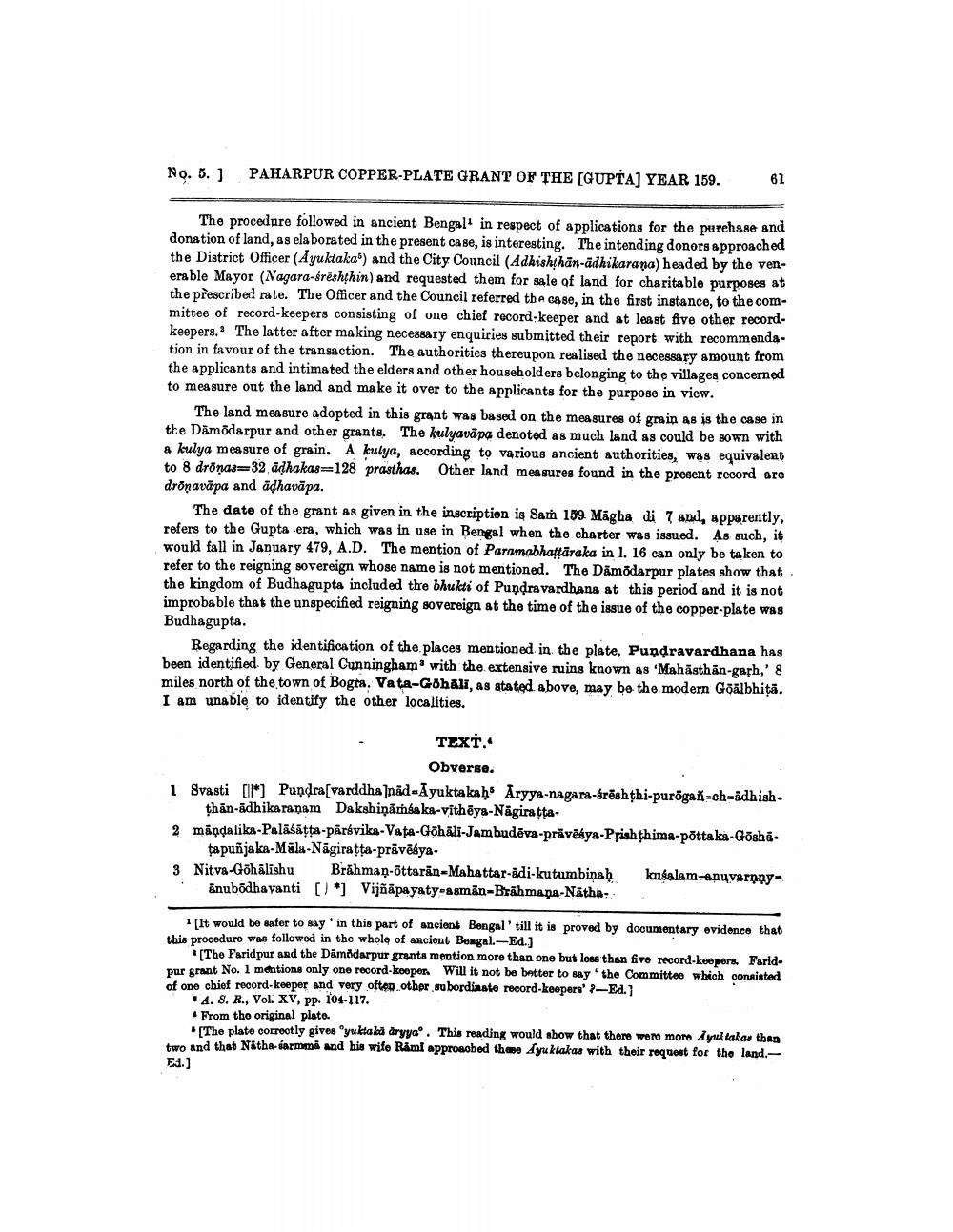________________
No. 5. )
PAHARPUR COPPER-PLATE GRANT OF THE (GUPTA) YEAR 159.
61
The procedure followed in ancient Bengali in respect of applications for the purehage and donation of land, as elaborated in the present case, is interesting. The intending donors approached the District Officer (Ayuktaka") and the City Council (Adhishthan-adhikarana) headed by the venerable Mayor (Nagara-brështhin) and requested them for sale of land for charitable purposes at the prescribed rate. The Officer and the Council referred the case, in the first instance, to the committee of record-keepers consisting of one chief record-keeper and at least five other recordkeepers. The latter after making necessary enquiries submitted their report with recommendation in favour of the transaction. The authorities thereupon realised the necessary amount from the applicants and intimated the elders and other householders belonging to the villages concerned to measure out the land and make it over to the applicants for the purpose in view.
The land measure adopted in this grant was based on the measures of grain as is the case in the Dämödarpur and other grants. The kulyavāpa denoted as much land as could be sown with a kulya measure of grain. A kulya, according to various ancient authorities, was equivalent to 8 dronas=32 ādhakas=128 prasthas. Other land measures found in the present record are dronavaрa and adhavйра.
The date of the grant as given in the inscription is Sam 109 Mägha di 7 and, apparently, refers to the Gupta era, which was in use in Bengal when the charter was issued. As such, it would fall in January 479, A.D. The mention of Paramabhattāraka in l. 16 can only be taken to refer to the reigning sovereign whose name is not mentioned. The Dämodarpur plates show that the kingdom of Budhagupta included the bhukti of Pundravardhana at this period and it is not improbable that the unspecified reigning sovereign at the time of the issue of the copper-plate was Budhagupta.
Regarding the identification of the places mentioned in the plate, Pundravardhana has been identified by General Cunningham. with the extensive ruins known as 'Mahästhan-gaph,' 8 miles north of the town of Bogta. Vata-Gohāli, as stated above, may be the modern Göälbhiţă. I am unable to identify the other localities.
TEXT.
Obverse. 1 Svasti lll Pundravarddha]nād=Āyuktakah Aryya-nagara-brēshthi-purögar-ch-adhish
than-adhikaranam Dakshiņāmsaka-vithēya-Nägiratta2 mándalika-Palasätta-pārsvika-Vata-Gõhāli-Jambudēva-prāvēsya-Pfish thima-põtta ka-Göshå
tapuñjaka-Mala-Nāgiratta-prāvēśya3 Nitva-Gõhālīshu Brāhman-õttaran-Mahattar-ādi-kutumbinah kusalam-apuvarnay
&nubodhayanti (1 *] Vijñāpayaty-asmān-Brāhmaṇa-Nätha:
1 [It would be safer to say in this part of ancient Bengal' till it is proved by documentary evidence that this procedure was followed in the whole of ancient Bengal. Ed.)
The Faridpur and the Damodarpur grants mention more than one but less than five record-keepers. Faridpur grant No. 1 mentions only one record-keeper. Will it not be better to say the Committee which consisted of one chief record-keeper and very often other subordiasto record-keepers' ?-Ed.)
. A. 8. R., VOL. XV, pp. 104-117. . From the original plato.
The plato correctly gives "yuktakd dryyao. This reading would show that there were more Ayultatas than two and that Näthe-sarmma and his wife Rámi approached the Ayuktakas with their request for the land.Ed.]




